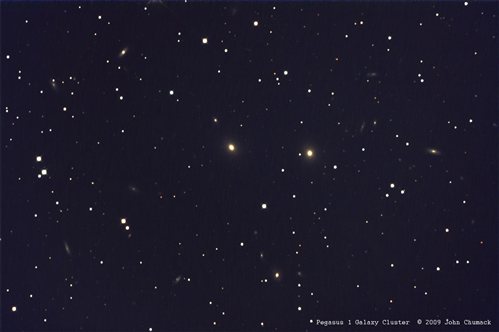Did you ever find yourself out under a clear, dark sky in November wondering what to look at? How about targeting a few objects in the constellation Pegasus, one of my favorite autumn constellations. Here are some suggestions:
Galaxy NGC 7479 is one of the most popular objects for viewing in the constellation, as it shows a distinct, nearly face-on barred spiral structure. Photos of NGC 7479 appear frequently in astronomy magazines and on the web and give this object a familiar form. This galaxy lies at the end of a long string of stars that appear starkly to viewers with a 3-inch scope. In a 6-inch scope, this galaxy appears as a bar with a faint haze surrounding it. Larger scopes show much more detail, however, including the asymmetrical arms arcing away from the central glow.
 How about targeting the two most conspicuous members of the Pegasus I galaxy cluster (pictured at right)? NGC 7619 and NGC 7626 are worth viewing even in small scopes. The galaxies lie just 7 arcminutes apart; the former shows a bright starlike nucleus while NGC 7626 has a tiny center.
How about targeting the two most conspicuous members of the Pegasus I galaxy cluster (pictured at right)? NGC 7619 and NGC 7626 are worth viewing even in small scopes. The galaxies lie just 7 arcminutes apart; the former shows a bright starlike nucleus while NGC 7626 has a tiny center.
If novelty’s your game, you could also target the first two objects in the NGC — NGC 1 and NGC 2. These galaxies are just 1.8' apart and are easily visible in a 6-inch scope under a dark sky.
Have you ever seen these galaxies? Do you spend time tracking down deep-sky objects in Pegasus? Let us know what your favorite November sky objects are and what you’re viewing them with.
Additional online observing resources from Astronomy magazine: